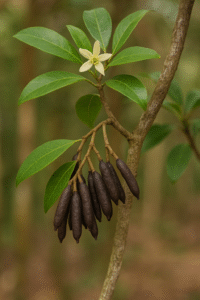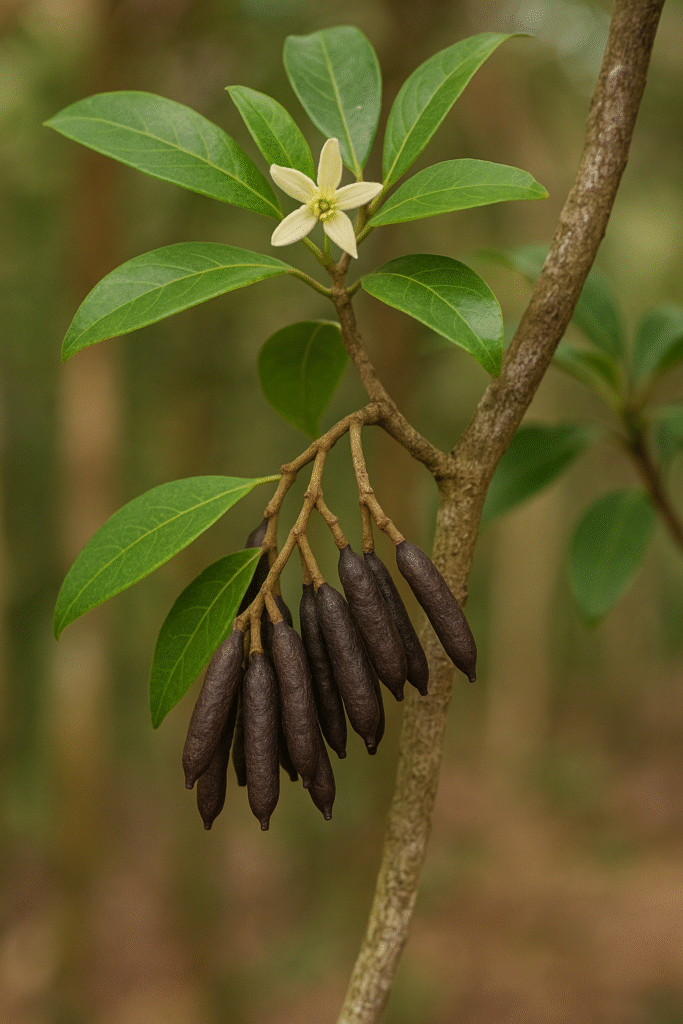Monkey pepper, scientifically known as Xylopia aromatica, is a native Brazilian plant widely appreciated for its medicinal properties and strong aroma. Also called “anador” or “wild painkiller,” this species belongs to the Annonaceae family — the same family as soursop and sugar apple — and has been used for generations by indigenous communities and traditional healers.
In this article, we’ll explore the botanical features, health benefits, how to grow it at home, and interesting facts about this unique plant that grows in Brazil’s cerrado biome. At the end, we’ll suggest a practical product to help you set up a stylish plant corner in your home.
Botanical Characteristics
Monkey pepper is a small to medium-sized tree, reaching up to 6 meters in height. It has a grayish bark with a slightly rough texture. The name “monkey pepper” comes from its long, dark pods that resemble tiny peppers, which are favored by monkeys and other wildlife.
Its leaves are simple, aromatic, and glossy green, emitting a fragrance similar to cloves or cinnamon when crushed. The plant blooms with small white flowers between September and November. The fruits ripen from November to January and are used both medicinally and in traditional rituals.
Natural Habitat
Monkey pepper is native to the Brazilian cerrado, a vast tropical savanna ecosystem. It’s found mainly in states like Goiás, Minas Gerais, Tocantins, and Bahia. With rising interest in native medicinal plants, people are now also growing monkey pepper in urban gardens, pots, and balconies.
Traditional Uses and Health Benefits
For centuries, monkey pepper has been known as a natural pain reliever, hence the nickname “wild anador.” Its fruits and leaves are used to make teas, infusions, and even therapeutic baths.
Here are some of its popular uses:
-
Pain relief: Tea made from the bark or fruits is used for headaches, muscle pain, and joint inflammation.
-
Respiratory support: It helps ease coughs and colds, acting as an expectorant.
-
Digestive aid: Consuming small doses after meals can help with digestion.
-
Topical use: Its extracts are applied externally for insect bites, bruises, or minor inflammation.
Although widely used in folk medicine, always consult a doctor or herbalist before using monkey pepper for medicinal purposes.
How to Grow Monkey Pepper
Growing monkey pepper is relatively easy, especially in warm and tropical climates. It prefers well-drained soil enriched with organic matter and thrives with partial or full sun exposure.
Basic growing tips:
-
Propagation: Can be grown from seeds or seedlings. Fresh seeds have higher germination rates.
-
Watering: Moderate watering is ideal—keep the soil moist but not soaked.
-
Fertilizing: Use compost or fertilizers rich in potassium and phosphorus.
-
Pruning: Regular pruning helps shape the plant and stimulate new growth.
Monkey pepper grows well in large pots or containers, making it suitable for balconies and patios.
Fun Facts
-
The fruit’s spicy aroma makes it useful as a natural seasoning in some regions.
-
Scientific studies are investigating its antioxidant and antimicrobial properties.
-
It’s commonly grown alongside other medicinal plants in agroecological gardens.
Why You Should Grow Monkey Pepper at Home
Besides its unique look and medicinal properties, monkey pepper adds a touch of rustic elegance to any green space. Whether you’re setting up a natural remedy corner or just love exotic plants, this is a great addition to your collection.
To display it beautifully and save space, we recommend using a versatile, multi-level plant stand.

🌿 Bring More Green to Your Space
Simple Trending Plant Stand
Indoor and outdoor metal stand with 3-tier shelves, perfect for showcasing flowers and herbs in your living room, balcony, or garden.
Search for it on Amazon by name or visit the link below:
🌳 Pau-Brasil: The Tree That Shaped a Nation
Symbol of Brazil’s history and identity, the Pau-Brasil is more than a tree —
it represents the roots of a nation and the richness of its natural heritage.
Discover the fascinating story behind this national treasure.

